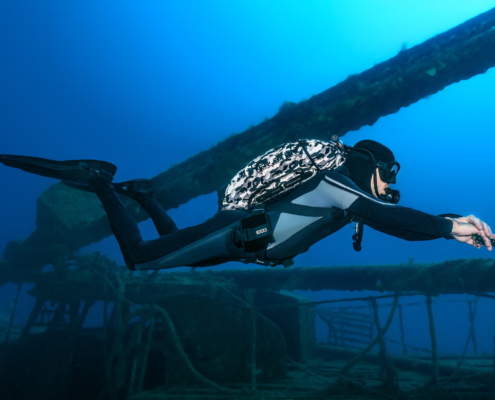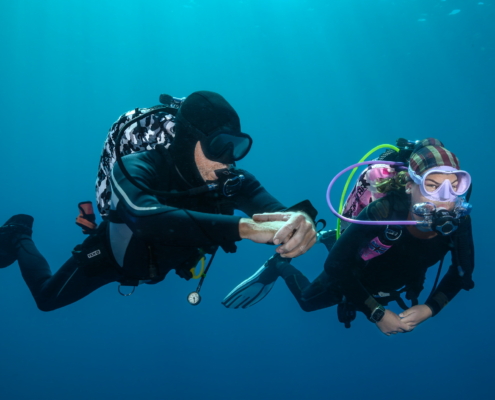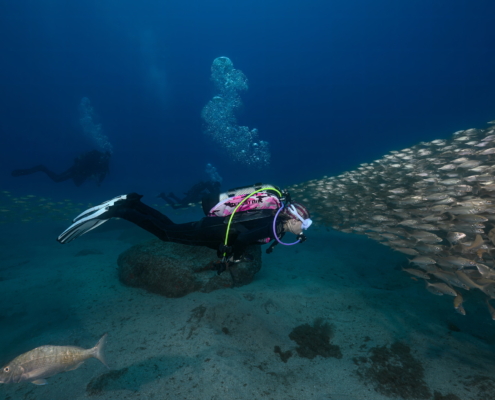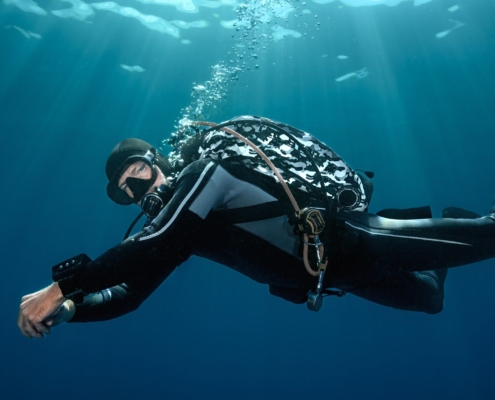Scuba Jackets Explained: Wings vs. BCDs and Why Wings Are on the Rise
Traditionally, divers have used jacket-style BCDs, but in recent years, wing-style BCDs have become increasingly popular. While both devices serve the same core purpose, the differences between them are significant and contribute to the growing shift toward wings, especially among experienced and technical divers.
1. Jacket-Style BCDs: The Traditional Choice
The jacket-style BCD is the most familiar to recreational divers and is often the first choice for beginners due to its ease of use and intuitive design.
Key Features:
- Surrounding Buoyancy: The bladder inflates around the diver’s torso, providing a comforting hug-like fit.
- Surface Buoyancy: Ample buoyancy at the surface, which is helpful for beginners in rough waters.
- Pockets: Most come with generous pockets which can be useful for accessories such as a torch or knife.
- Integrated Weights: Many jacket BCDs come with integrated weight systems, allowing divers to balance themselves without the need for a separate weight belt.
Drawbacks:
- Drag: The all-around inflation of the jacket increases water resistance, making movement less efficient.
- Bulk: The protective padding adds to buoyancy, which requires the diver to use more weight to descend.
- Poor Design of Integrated Weight Systems: We regularly see BCDs with a poor latch system resulting in divers losing some of their weights, and in danger of a rapid ascent. Furthermore, the integrated weights are often positioned in such a way that the diver’s body position in the water resembles a seahorse.
- Plastic Buckles: Most BCDs use plastic buckles which are prone to failure.
- Size determines lift: BCDs are sized from childrens through to XXXL. The bigger the jacket, the greater the capacity in the bladder for air for lift. At the extremes we find there’s not as much lift as we’d like in the smallest sizes whereas the larger sizes have more than necessary. In addition a jacket that fits around a larger body is often loose at the shoulders and moves around rather than fitting snugly.
- Less Streamlined Control: Uneven air distribution makes it harder to achieve a horizontal swimming position (trim).
2. Wing-Style BCDs: The Modern Diver’s Tool
Wing-style BCDs, often simply called Wings, are a favorite among technical divers and those seeking more advanced buoyancy control and efficiency underwater.
Key Features:
- Back-Mounted Bladder: The air bladder is positioned solely on the back, reducing water resistance and streamlining the diver’s shape.
- Customizable Setup: Modular design allows for increased personal choice of setup.
Why Are Wings Becoming More Popular?
While Wings were initially favored by technical divers, more recreational divers are turning to them as they recognize their numerous advantages:
- Increased Efficiency Underwater: Wings reduce bulk and drag, making movement smoother and more efficient.
- Customizability: The modular design allows divers multiple options to suit their size and preferences. Starting with the choice of backplate – heavy for those wishing to reduce the weight in their pouches or belt, lighter for those wishing to travel with their dive kit. As the harness is added to the backplate, there are choices relating to comfort, positioning of D rings, weight pouches, pockets or other accessories. Finally the choice of bladder, which can be suited to single or twin tank diving. Divers can use the same backplate and harness with either their single or twin-tank bladders, and to swap from one to the other is quick and easy.
- Durability: Wings naturally support a horizontal swimming position, making buoyancy adjustments easier and more effective.
- Flexibility: The modular nature of a wing allows for the set up to be changed at any time.
Conclusion: Why Choose Wings Over Jacket BCDs?
Jacket-style BCDs remain popular among beginners and those making only occasional dives. They may feel more confident diving with the same style of kit that they trained with, and this is an important consideration. However, wings are increasingly seen as the superior option for divers seeking more control and adaptability. The streamlined design, enhanced buoyancy control, and modularity make wings an excellent investment for divers aiming to improve their skills and performance underwater.
Ready to experience the benefits of a wing-style BCD for your next dive? At Aqua-Marina you can try diving with a wing with advice from our experienced instructors. Discover how we can help you enhance your
underwater adventures!








